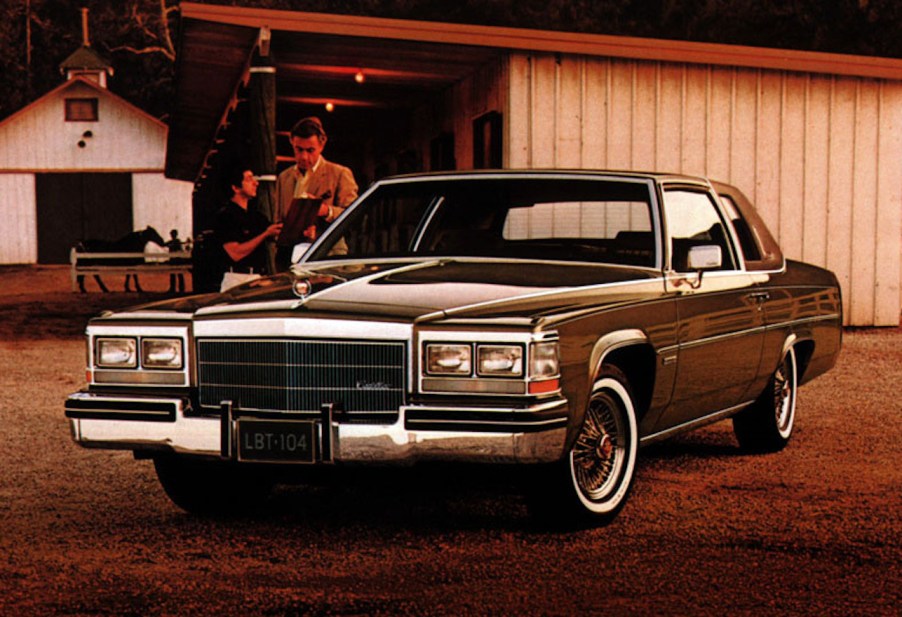
When Cadillac’s Terrible 4-6-8 Engine Was Replaced With Worse HT4100 V8
When a company tells you its latest development is “high tech,” it means it utilizes the latest in technology. Especially in the late 1970s, when Cadillac told you so, then it was, especially in those days of staunch brand loyalty. After the hot mess that was the 4-6-8 V8, and Oldsmobile’s diesel disaster, GM needed a homerun with its latest powerplant, the “HT4100” V8. But doomed by GM hubris and repeating some of the same mistakes that occurred with the 4-6-8, the HT4100 helped nail Cadillac’s casket shut for decades.
When did the Cadillac HT4100 debut?

Just to refresh, Cadillac debuted its new 4-6-8 V8 with the first computer-controlled cylinder deactivation in 1981. While a brilliant idea, computer technology couldn’t keep up with the engine’s demands. It was so bad that the automaker dropped it at the end of the year.
But that left Cadillac in a deep hole. The new HT4100 V8 was intended for the all-new 1983 front-wheel drive Cadillacs. Now, development had to be cut short to make it into the 1982 models. The late development stages of new engine designs are critical, yet Cadillac had no choice.
What was the Cadillac HT4100 available in?

Cadillac’s 4.1-liter V8, code-named LT8, would replace Cadillac’s 6.0-liter V8. It was used for both front- and rear-wheel platforms. And for its first year or two, it would be exclusive to GM’s flagship Cadillac brand. But there were other problems hurting the effort as GM’s plans kept changing.
Intended for front-wheel drive models, due in 1983, they were postponed again and again before debuting in 1985. So, for three more years, those heavier, larger Cadillacs were now saddled with 135 hp LT8s. By 1985, the gas shortages of the 1970s were but a distant memory. But Cadillac buyers weren’t asking for a smaller Cadillac in 1985, but that’s another story for another time.
So every model in the Cadillac lineup with the exception of the disastrous Cimarron got the all-new HT4100 as the standard engine. Optional was the 4.1-liter V6, and anyone not paying attention to the previous year could still order a diesel V8. By 1985, the Fleetwoods and Allante, another GM mistake, got it.
What kinds of problems did the Cadillac HT4100 have?

With cylinder activation eliminated, the former 4-6-8 ECU was reworked to monitor engine performance. The results were displayed right on the dash. This was so the driver could see how much effort the small engine experienced.
Almost immediately after the first sales problems began piling up at Cadillac service departments. The block was a combination of aluminum blocks and iron heads, but with metal cylinder sleeves. The intake was also aluminum. But iron and aluminum expand and contract at different temperatures and at different rates.
Another GM technology problem was the use of RTV silicone instead of OG gaskets. GM was hot to eliminate gaskets and had been developing its RTV technology for the HT4100. But it wasn’t ready for prime time, which was part of the cascade of bad to follow.
At least was mileage improved?

Weak block castings, one victim of the rush to production, resulted in head bolts pulling out, taking the threads with them. With aluminum in high-stress areas, and the cylinder sleeves doing their own thing, intake manifolds began failing. Camshaft bearings began eating themselves alive, and the aluminum oil pumps started failing as well. And this was all within the first month or two in the field.
Then there was the bad mileage. Because the engine had as much power as a refrigerator, drivers were constantly pushing the gas pedal to the floor. With all of the full-throttle blasts necessary to get these 5,000 lb behemoths out of their own way, mileage numbers tanked. But Cadillac had no choice and kept pounding out HT4100 stomach pumps. Surprisingly, sales went up in spite of the disaster awaiting buyers.
The final version of the engine made it into the all-new 1987 Allante Mercedes-fighter two-door. But GM couldn’t let it go in as it was. So it took steps to improve it and gain some more horsepower.
How was the HT4100 improved, or was it?

Camshaft profiles were revised, and hydraulic roller lifters replaced the straight hydraulic lifters. Now, it achieved 170 hp. Still not a rocketship, but much improved from its original 135 hp.
So in just a short time span, GM had produced three of the worst production engines the world had ever seen. The 4-6-8 V8, Oldsmobile diesel, and the Cadillac HT4100 set GM products on a path culminating in bankruptcy by 2010. While some say the public has a short memory, car buyers never forgot the domino of bad products the general pulled out in the 1970s and 1980s.
And we haven’t even mentioned the 2.3-liter banger it wrought for the all-new Chevrolet Vega, its VW beater. That is also another story for another time, as is GM’s X-cars starting in 1980. And there are more and more, so bad you can’t forget.




